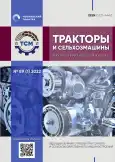Расчет минимально необходимого количества моторного масла на трущихся поверхностях ЦПГ быстроходного дизеля
- Авторы: Путинцев С.В.1, Aникин С.А.2, Деменкова С.П.1, Стрельникова С.С.3
-
Учреждения:
- Московский государственный технический университет им. Н.Э. Баумана
- Военная академия воздушно-космической обороны им. Г.К. Жукова
- Институт машиноведения им. А.А. Благонравова
- Выпуск: Том 89, № 1 (2022)
- Страницы: 53-65
- Раздел: Качество, надёжность
- URL: https://journals.rcsi.science/0321-4443/article/view/100063
- DOI: https://doi.org/10.17816/0321-4443-100063
- ID: 100063
Цитировать
Полный текст
Аннотация
Введение. Актуальность темы статьи обусловлена нерешенностью проблемы надежной и экономичной работы форсированных быстроходных поршневых двигателей. Важным аспектом решения этой проблемы является рациональное маслоснабжение цилиндропоршневой группы (ЦПГ).
Цель, задачи и объект исследования. Цель состояла в оценке минимального объема моторного масла, необходимого для гидродинамического режима смазки пары цилиндр – юбка поршня. В работе ставились и решались задачи определения объема моторного масла, способного заполнить: 1) впадины плосковершинной поверхности цилиндра; 2) рельефной поверхности юбки поршня и 3) радиальный зазор указанной выше пары. Объектом исследования являлся быстроходный дизель.
Методы решения. Для расчета объемов масла применяли три разновидности аналитического определения суммарного объема впадин шероховатой поверхности и зазора между сопрягаемыми поверхностями цилиндра и юбки поршня.
Результаты и их обсуждение. Установлено, что расчет на основе известной формулы маслоемкости (метод 1) дает по сравнению с методами 2 и 3, учитывающими реальную геометрию впадин и параметры шероховатости, примерно на 15% завышающий результат оценки объема масла. В результате работы определено преимущество метода 3 по критериям большего обобщения и простоты применения. С помощью метода 3 получено оценочное значение минимально необходимого объема масла для обеспечения гидродинамического режима смазки пары цилиндр – юбка поршня объекта исследования.
Заключение. Полученные в работе аналитические выражения согласно методу 3 могут быть рекомендованы для оптимизации систем смазки ДВС с целью не только снижения потерь на трение и изнашивание, но и минимизации риска появления масляного голодания и повышенного расхода масла на угар.
Ключевые слова
Полный текст
Открыть статью на сайте журналаОб авторах
Сергей Викторович Путинцев
Московский государственный технический университет им. Н.Э. Баумана
Автор, ответственный за переписку.
Email: putintsev50@yandex.ru
ORCID iD: 0000-0002-3793-7273
SPIN-код: 3124-0375
доктор технических наук, профессор
Россия, 105005, Москва, 2-я Бауманская ул., д. 5, стр. 1Сергей Алексеевич Aникин
Военная академия воздушно-космической обороны им. Г.К. Жукова
Email: s.a.anikin@mail.ru
кандидат технических наук, доцент
Россия, ТверьСофия Павловна Деменкова
Московский государственный технический университет им. Н.Э. Баумана
Email: at-demenkov0@mail.ru
ORCID iD: 0000-0002-0846-3910
SPIN-код: 6835-5323
бакалавр техники и технологий
Россия, 105005, Москва, 2-я Бауманская ул., д. 5, стр. 1Софья Сергеевна Стрельникова
Институт машиноведения им. А.А. Благонравова
Email: sofya.s.strelnikova@yandex.ru
ORCID iD: 0000-0003-4787-4605
SPIN-код: 6332-1272
младший научный сотрудник
Россия, МоскваСписок литературы
- Walch S., Hick H., Edtmayer J., et al. Multimethod concept for continuous wear-analysis of the piston group // SAE Technical Paper. 2018. N 2018-01-0839. doi: 10.4271/2018-01-0839
- Tormos B., Martín J., Carreño R., Ramírez L. A general model to evaluate mechanical losses and auxiliary energy consumption in reciprocating internal combustion engines // Tribology International. 2018. Vol. 123. P. 161–179. doi: 10.1016/j.triboint.2018.03.007
- Wróblewski E., Finke S., Babiak M. Investigation of friction loss in internal combustion engine of experimental microgeometry piston bearing surface // Journal of KONES. 2017. Vol. 24, N 2. P. 307–313. doi: 10.5604/01.3001.0010.2951
- Meng Z., Ahling S., Tian T. Study of the Effects of Oil Supply and Piston Skirt Profile on Lubrication Performance in Power Cylinder Systems // SAE Technical Paper. 2019. N 2019-01-2364. doi: 10.4271/2019-01-2364
- Li H., Liu H., Jiang S., Chang J. A study on the oil transport in piston skirt-cylinder liner under fully flooded conditions using improved SPH simulations // Engineering Analysis with Boundary Elements. 2019. Vol. 109, P. 176–186. doi: 10.1016/j.enganabound.2019.09.017
- Путинцев С.В., Аникин С.А., Ратников А.С. Аналитико-расчетное сопоставление гладкой и шероховатой поверхностей трения цилиндра поршневого двигателя с позиций гидродинамики и трибологии // Автомобильная промышленность. 2018. № 7. С. 13–17.
- Пашкевич В.М., Афаневич В.В. Компьютерное моделирование и анализ маслоемкости поверхности // Вестник Могилевского государственного технического университета. 2006. № 1. С. 198–204.
- Кузнецов В.П., Дмитриева О.В. Моделирование и исследование формирования плосковершинного микрорельефа поверхностей трения со смазочными микрокарманами при многоцелевой обработке деталей // Известия Томского политехнического университета. 2011. Т. 319. № 2. С. 35–40.
- Минаков А.П., Ящук О.В., Соколов В.Н., Павлович В.П. Аналитический обзор методик определения маслоемкости поверхности зеркала гильзы двигателя внутреннего сгорания // Вестник машиностроения. 1999. № 10. С. 14–16.
- Баранов В.Л., Дронов Е.А., Лаврухин В.Н., Третьяков Н.В. Финишная обработка внутренней поверхности цилиндров двигателя внутреннего сгорания // Известия Тульского государственного университета. Технические науки. 2016. № 12–2. С. 15–21.
- Путинцев С.В., Агеев А.Г. Результаты моделирования деформации юбки поршня быстроходного дизеля от действия гидродинамического давления масла // Двигателестроение. 2015. Т. 261, № 3. С. 18–21.
- Митин И.В., Непогодьев А.В. Новый метод измерения испарения масла при испытаниях ДВС // Двигателестроение. 1981. № 8. С. 45–47.
Дополнительные файлы














